
|
|
FYBUSH.COM/SITE OF THE WEEK
NEEDS YOUR SUPPORT! (AND YOU CAN GET A FREE TOWER SITE CALENDAR
IF YOU PLEDGE NOW...) CLICK HERE
TO LEARN MORE...
April 22-29, 2004
The AM Stations of Montreal, Quebec
(EDITOR'S NOTE: We're rerunning this feature for two reasons: first, we're out west this week at the NAB convention - and also gathering some more exciting Sites of the Week for you. Second, we goofed: our images of CIQC, CFMB 1280 and CFMB 1410 were mislabeled the first time we ran this. So here's the corrected version - and we'll continue on with Ottawa on April 29!)
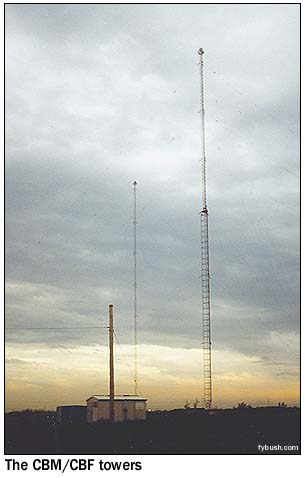
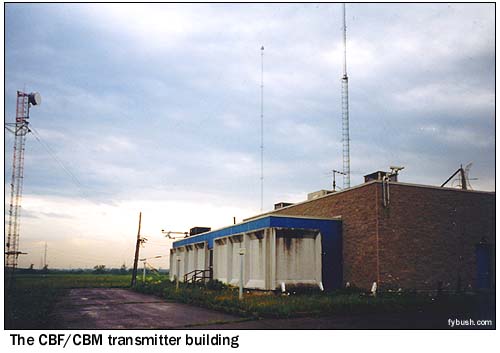
When we left you two weeks ago (before taking our little detour into April Foolery with our visit to WVWA), we were still recounting our summer 1998 trip down the spine of Quebec, all the way from Riviere-du-Loup to the Ontario border. And after visiting Trois-Rivieres, the next major city is the major city of Francophone Canada, Montreal itself.
A quick geography lesson: Montreal sits on an island astride the confluence of the St. Lawrence and Ottawa Rivers, shaped somewhat like a backwards L and oriented southwest-to-northeast. (Montrealers tend to look at things on a somewhat rotated axis; "Montreal East" actually points northeast, while "Montreal West" points southwest, which explains why the "South Shore" of the river includes some areas that are decidedly east of the city.)
The South Shore is where we find nearly all of Montreal's AM facilities, too, as you'd expect from a city where most of the AM facilities have to protect the U.S. border, an hour or so to the south, with big directional arrays.
When we visited in June 1998, the CBC was still in its waning days on the AM dial in Montreal, operating CBF (690) and CBM (940) from a very visible site on boulevard des Prairies in Brossard, across the river east of Montreal near the end of the Champlain Bridge. The tall tower at this site carried Radio-Canada's CBF, while both towers made up the directional array for CBM's 50 kilowatts.
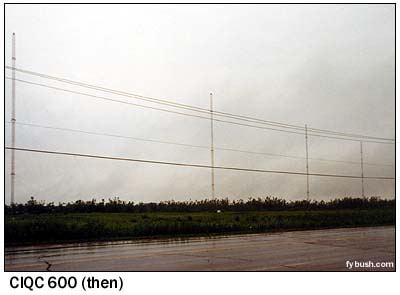 Within
a few months after our visit, both signals would be replaced
by FM outlets, which were already on the air simulcasting even
then: CBF on 95.1, CBME on 88.5 with a most inferior signal compared
to the big 940.
Within
a few months after our visit, both signals would be replaced
by FM outlets, which were already on the air simulcasting even
then: CBF on 95.1, CBME on 88.5 with a most inferior signal compared
to the big 940.
The 690 and 940 signals would remain silent for a year or so, eventually being replaced by two all-news stations: French CINF ("Info 690") and English CINW ("940 News"), which took over the transmitter site of the English-language outlet that CINW replaced. CIQC 600, descendant of CFCF, Canada's oldest radio station, used four towers on Highway 138 near the Kahnawake Indian Reserve, at the other end of the South Shore near the Mercier Bridge, an ideal site to shoot a signal across the river into the Anglophone communities of Montreal's West Island. Those four towers (seen above in a photomontage) are still in use today, shared between CINW and CINF in a configuration that I've never quite been able to piece together. The 690 and 940 signals have never been as strong from the new site as they were from Brossard - and at last word, the CBC Brossard site was still standing, unused.
CINF's predecessor, CKVL (850), operated from a site a few kms to the east, somewhere near Ste.-Catherine. We didn't make it there on the 1998 trip, and it was gone when I returned to Montreal in the fall of 2002.
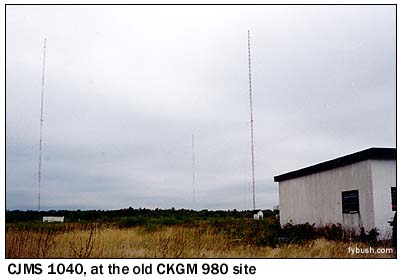
|
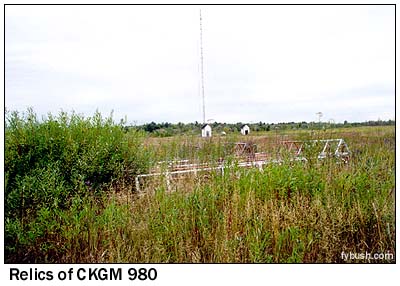
|
CKGM went through a prolonged series of death throes in the 1980s, flipping to AC, then returning to top 40 as CHTX, "980 Hits." And on September 14, 1990, CHTX moved to 990, increasing its power to 50,000 watts from a new transmitter site far south of Montreal at Ville-de-Mercier. The seven towers are set far back from the road, and the 50 kW signal is quite directional to the north, as you'd expect.
In later years, CHTX went oldies as CKIS, then returned to the CKGM calls with talk, but failed to attract an audience. After a brief period carrying CJAD's news-talk programming (we'll explain why in a moment), CKGM went back to oldies, then flipped to the CHUM Group's "Team" sports format when it launched nationally in 2001. While the national "Team" format is now dead, CKGM has carried on with it - and it's far and away the lowest-rated English-language signal on the Montreal dial.
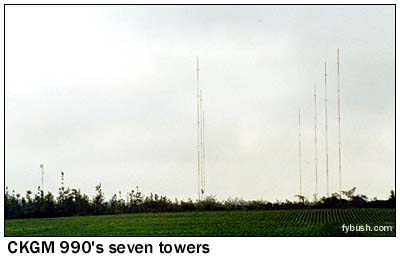 |
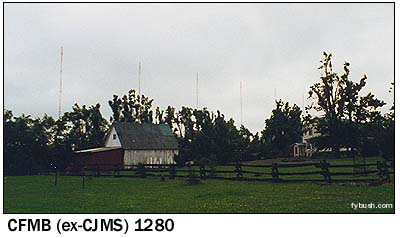
|
In 1997, CFMB took its old 1410 facility silent and moved to the 1280 site, six towers in St. Mathieu, south of St. Constant along the Autoroute 15 freeway that eventually becomes I-87 when it crosses the New York border.
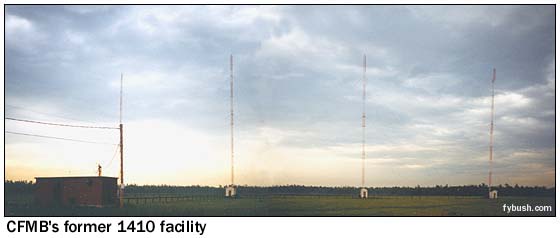 The
six 1410 towers were still standing when we visited in 1998,
though they've since been demolished, I'm told. (As for the 1280
site, the woman gardening in front of that farmhouse in the foreground
of the picture was quite curious about why we were photographing
her house; I'm not sure she quite got our explanation of what
we were really interested in!)
The
six 1410 towers were still standing when we visited in 1998,
though they've since been demolished, I'm told. (As for the 1280
site, the woman gardening in front of that farmhouse in the foreground
of the picture was quite curious about why we were photographing
her house; I'm not sure she quite got our explanation of what
we were really interested in!)
Before 1410 was torn down, though, it played a brief final role in Montreal radio history. In January 1998, the region was hit by one of the worst ice storms in history. The storm knocked out power in a region that stretched from western New York deep into Quebec, leaving some residents with no electricity for several weeks. And it toppled several broadcast towers, including the tall tower of CKWS-TV/CFMK-FM in Kingston, Ontario - and the four towers of CJAD (800), Montreal's big commercial English-language news-talker.
With its site on Highway 221 in St.-Edouard out of service for the duration, CJAD turned to CFMB for help, reactivating the 1410 site to carry CJAD programming in the immediate aftermath of the storm. As a stopgap, it was somewhat mediocre; the 1410 signal is notoriously bad to the west, which meant that the Anglophone target community on the West Island had a lot of trouble hearing CJAD on its new frequency. Beginning on January 26, 1998, CJAD programs were instead heard over CKGM's 990 facility, which CHUM leased out to CJAD owner Standard Radio for three months, enough time to get new towers built at St.-Edouard. On June 12, 1998 - just two weeks before we passed through - CJAD returned to 800 and CKGM went back to oldies.
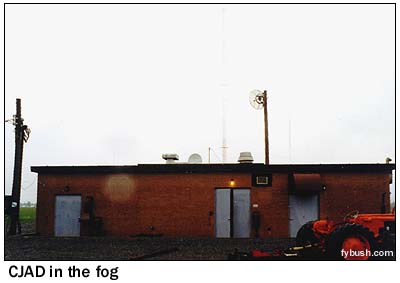
|
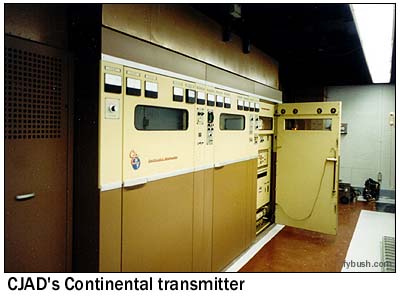
|
(The ice storm had another effect on Montreal broadcasting: the need to get emergency information out to the devastated Monteregie region south of Montreal, where the power losses were more severe and longer-lasting than anywhere else, led Radio-Canada to activate its 95.1 transmitter earlier than scheduled. So before the CBF "premiere chaine" Radio-Canada programming ever made it on the air on 95.1, the signal was in use as an emergency programming service for the Monteregie. Once the emergency passed, the transmitter stayed on with a simulcast of 690.)
Two more Montreal AMs had gone dark before our 1998 visit: CKLM (1570) had operated from Laval, north of the river, while CKO (1470), the descendant of top-40 CFOX, operated from Chateauguay on the South Shore, opposite its community of license, Pointe-Claire, on the West Island. Both sites were gone before we ever arrived; 1570 has since been reactivated from a new site as CFAV, Radio Nostalgie.
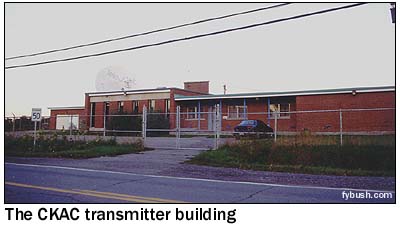
|
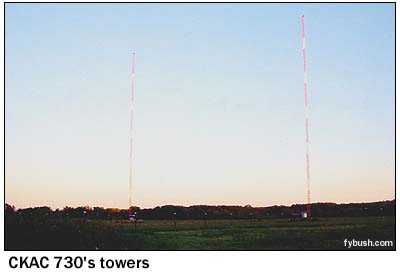
|
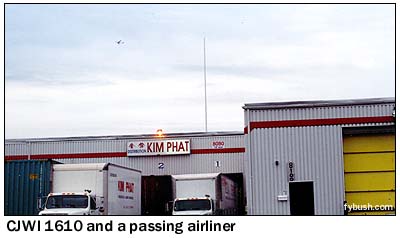 And
we'll close with a station that wasn't even on the air yet in
1998. CJWI (1610) signed on in 2002 as "CPAM Radio Union,"
another multilingual station to complement CFMB with service
to the Haitian and other newer immigrant communities in Montreal.
And
we'll close with a station that wasn't even on the air yet in
1998. CJWI (1610) signed on in 2002 as "CPAM Radio Union,"
another multilingual station to complement CFMB with service
to the Haitian and other newer immigrant communities in Montreal.
After a pleasant visit with the nice folks at the "International Radio Report," which airs on CKUT (90.3) on Sunday mornings from 10:30-11 AM (you can listen live at www.ckut.ca) and an afternoon of what turned out not to be the last Expos game in Montreal, we found CJWI's short Valcom fiberglass whip antenna mounted atop a warehouse building on boulevard Jarry (near boul. Pie IX north of Autoroute 40) on the East End of Montreal. It's not much of a groundwave signal - indeed, we had trouble hearing it in our Montreal hotel room - but the skywave carries quite well at night on the sparsely-populated 1610 frequency, and it's been widely heard since its debut.
And that's it for Montreal's AM stations. Next week, we'll wrap up that 1998 trip by looking at Ottawa's AM facilities!
Still haven't ordered? It's not too late - Tower Site Calendar 2004 is STILL AVAILABLE! All orders placed by Tuesday, April 6 have now been shipped - and if you haven't yet ordered, what are you waiting for? Click here for ordering information!
- Previous Site of the Week: WVWA AM-FM-TV, Pound Ridge, N.Y.
- Next Week: Ottawa's AM Towers
- Site of the Week INDEX!
- How can you help support Site of the Week? Click here!
- Submit your suggestions for a future Site of the Week!
